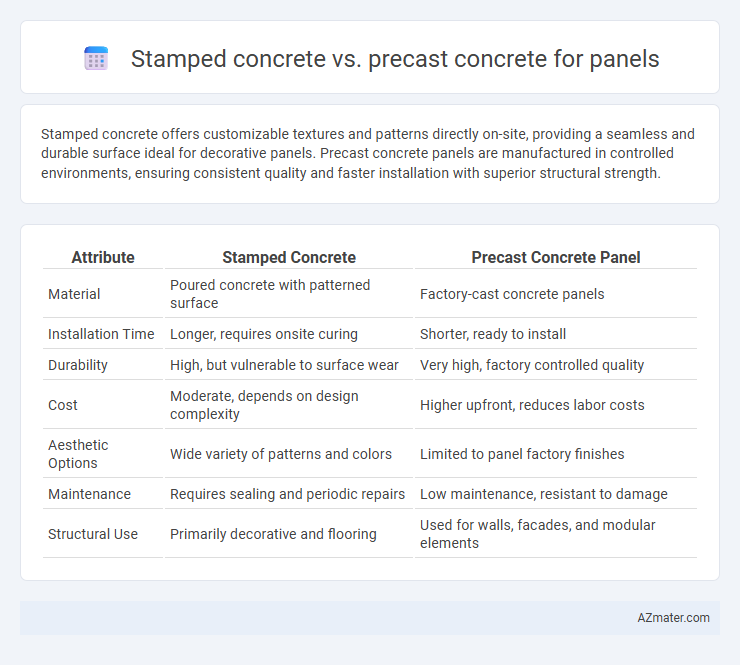Stamped concrete offers customizable textures and patterns directly on-site, providing a seamless and durable surface ideal for decorative panels. Precast concrete panels are manufactured in controlled environments, ensuring consistent quality and faster installation with superior structural strength.
Table of Comparison
| Attribute | Stamped Concrete | Precast Concrete Panel |
|---|---|---|
| Material | Poured concrete with patterned surface | Factory-cast concrete panels |
| Installation Time | Longer, requires onsite curing | Shorter, ready to install |
| Durability | High, but vulnerable to surface wear | Very high, factory controlled quality |
| Cost | Moderate, depends on design complexity | Higher upfront, reduces labor costs |
| Aesthetic Options | Wide variety of patterns and colors | Limited to panel factory finishes |
| Maintenance | Requires sealing and periodic repairs | Low maintenance, resistant to damage |
| Structural Use | Primarily decorative and flooring | Used for walls, facades, and modular elements |
Understanding Stamped Concrete Panels
Stamped concrete panels offer customizable surface textures and patterns that replicate natural materials like stone or brick, enhancing aesthetic appeal for walls and facades. These panels provide durability and weather resistance comparable to traditional precast concrete but allow for greater design flexibility on-site. Understanding the composition and installation process of stamped concrete panels is essential for optimizing their structural performance and visual impact in architectural projects.
Overview of Precast Concrete Panels
Precast concrete panels are manufactured in controlled factory environments, ensuring high precision, quality, and durability for building applications. These panels offer consistent strength and dimensional accuracy, making them ideal for rapid construction and uniform aesthetics. Compared to stamped concrete, precast panels provide superior structural integrity and faster installation times, reducing on-site labor costs and weather-related delays.
Installation Process: Stamped vs Precast Concrete
Stamped concrete offers a seamless installation process by being poured and patterned on-site, allowing customization and quicker completion for panels. Precast concrete panels are manufactured in controlled factory settings, ensuring high quality and uniformity but requiring transportation and crane lifting for installation, which may extend timelines. The choice between stamped and precast panels depends on project-specific factors such as site accessibility, desired aesthetic, and installation speed.
Aesthetic Flexibility and Design Options
Stamped concrete offers extensive aesthetic flexibility by mimicking textures such as stone, brick, or wood with customizable colors, patterns, and impressions, allowing for unique, site-specific designs. Precast concrete panels provide consistent, factory-controlled finishes with options for smooth, textured, or patterned surfaces, but design modifications are limited once produced. The choice depends on whether on-site creative customization or uniform, repeatable design elements are prioritized in a project.
Durability and Longevity Comparison
Stamped concrete offers customizable designs with moderate durability, but it is prone to surface wear and cracking over time, especially in harsh weather conditions. Precast concrete panels provide superior durability and longevity due to factory-controlled production, reducing risks of shrinkage and cracking while maintaining structural integrity for decades. The enhanced curing process and dense composition of precast concrete significantly extend lifespan, making it a preferred choice for long-term panel applications.
Cost Analysis: Stamped vs Precast Panels
Stamped concrete panels often have higher initial costs due to detailed mold creation and labor-intensive finishing processes, yet they offer customizable aesthetics that can increase property value. Precast concrete panels typically provide lower production and installation costs due to factory-controlled casting, faster curing times, and streamlined assembly on-site. Long-term expenses for stamped panels may rise with maintenance for preserving texture and color, whereas precast panels generally have reduced upkeep costs, making them more economically efficient over time.
Maintenance Requirements
Stamped concrete requires regular sealing every 2-3 years to protect against cracking, fading, and surface wear, ensuring long-term durability and appearance. Precast concrete panels exhibit lower maintenance needs, primarily involving occasional cleaning and inspecting joints for potential damage or shifting. The inherent factory-controlled curing process of precast panels results in enhanced strength and resistance, reducing the frequency and cost of repairs compared to stamped concrete surfaces.
Environmental Impact and Sustainability
Stamped concrete often requires on-site pouring, which can lead to higher water usage and potential waste due to mixing inconsistencies, whereas precast concrete panels are manufactured in controlled environments, reducing material waste and energy consumption. Precast concrete promotes sustainability by enabling recycling of molds and minimizing onsite emissions, contributing to lower carbon footprints compared to stamped concrete. Environmental impact assessments typically favor precast panels for their efficiency in resource use and potential for integrating recycled materials, supporting green building certifications.
Best Applications for Each Concrete Type
Stamped concrete offers superior aesthetic appeal and is best suited for decorative applications such as patios, driveways, and walkways where visual texture and custom patterns are desired. Precast concrete panels provide enhanced structural strength and uniformity, making them ideal for large-scale construction projects, including building facades, retaining walls, and infrastructure components. Selecting stamped concrete optimizes design versatility, while precast concrete ensures efficiency and durability in repetitive, load-bearing panel applications.
Making the Right Choice for Your Project
Stamped concrete offers customizable patterns and textures ideal for decorative panels, providing a seamless and unique finish that enhances aesthetic appeal. Precast concrete panels deliver superior strength, consistent quality, and faster installation due to factory-controlled conditions, making them suitable for structural and repetitive applications. Selecting between stamped and precast concrete depends on project priorities such as visual design, durability requirements, installation timeline, and budget constraints.

Infographic: Stamped concrete vs Precast concrete for Panel
 azmater.com
azmater.com